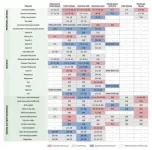(Press-News.org)
Traditional epidemiological studies have identified numerous potential risk factors, but observational studies have struggled to establish causal links due to confounding factors and reverse causation. Theoretically avoiding confounding and reverse causation, Mendelian randomization (MR) infers causality, offering novel research perspectives and methods for investigating risk factors of intestinal diseases (Figure 1).
MR research on intestinal disease
Based on MR methodology, researchers have identified lifestyle factors, circulating nutrients, and obesity as being associated with the risk of various intestinal diseases (Figure 2). Unhealthy lifestyle habits such as alcohol consumption, smoking, insomnia, and sedentary behavior can increase the risk of bowel diseases like colorectal cancer and inflammatory bowel disease. Conversely, a healthy lifestyle, including regular exercise, can reduce the risks of these diseases. Some studies have found that vitamins A, C, D, E, and Omega-3 and 6 fatty acids may protect play a protective role in inflammatory bowel disease and colorectal cancer development. MR studies have also examined the effects of obesity and dyslipidemia on bowel disease. High body mass index, excess body fat, and a large waist-to-hip ratio have been associated with an increased risk of colorectal cancer, Crohn's disease, diverticular disease, and irritable bowel syndrome. These findings suggest that modifying lifestyle habits and optimizing diet can potentially reduce the risk of bowel disease.
MR studies have also identified causal associations between various inflammatory protein biomarkers and the risk of intestinal disease. For example, genetically predicted higher levels of IL-16, IL-18, and CXCL10 were associated with increased inflammatory bowel disease risk, while genetically predicted IL12p70 and CCL23 levels was associated with decreased risks of inflammatory bowel desease. Proteome-wide MR studies have revealed potential therapeutic targets, such as MST1, HGFAC, STAT3, ITPKA, and CXCL5, which play significant roles in inflammatory bowel disease. Genetically predicted higher GREM1 and CHRDL2 levels, along with lower CLSTN3 and POLR2F levels, are associated with an increased risk of colorectal cancer. These findings provide important insights for developing new drugs for intestinal diseases.
Drug target investigations using MR in intestinal diseases can be broadly categorised into two approaches. Proteome-wide analyses related numerous circulating proteins to disease outcomes, typically validating established while uncovering novel pharmacological targets that could inform drug development efforts. Repurposing studies focused on interrogating whether existing drugs developed for other indications might harbour additional therapeutic utility in intestinal diseases and evaluated the safety in intestinal, exemplified by evaluating antihyperlipidaemic and antihypertensive agents.
MR has also been used to investigate the association between intestinal flora and its metabolites with intestinal diseases. Additionally, MR has been employed to elucidate the associations between intestinal diseases and other diseases, such as psychiatric disorders, hepatobiliary and pancreatic diseases and autoimmune diseases (Figure 3).
Future perspectives of MR study in intestinal diseases
Integrating multiomics data through MR represents a promising future direction to uncover more complex mechanistic pathways.
Leveraging research designs with different strengths and sources of bias allowed the triangulation of findings.
When composing an MR paper, researchers should refer to the Strengthening the Reporting of Observational Studies in Epidemiology (STROBE)-MR guidelines to ensure the quality of their manuscript, which contributes to enhancing the quality of MR studies and ensuring their credibility and reproducibility.
Larger sample sizes are needed to achieve the power required to detect variants especially of smaller effect for exposure, and larger sample sizes will be also needed for intestinal disease particularly for less heritable disorders.
Most MR studies have focused on European populations, which may not be generalizable to other ancestries. It is encouraged to explore MR associations in populations with different ancestries.
See the article:
Xixian Ruan, Tianyi Che, Xuejie Chen, Yuhao Sun, Tian Fu, Shuai Yuan, Xue Li, Jie Chen, Xiaoyan Wang - Mendelian randomisation analysis for intestinal disease: achievement and future: eGastroenterology 2024;2:e100058.
https://doi.org/10.1136/egastro-2023-100058
About the eGastroenterology
eGastroenterology is a new, open-access, and open peer-reviewed BMJ Journal, which focuses on basic, clinical, translational, and evidence-based medicine research in all areas of gastroenterology (including hepatology, pancreatology, esophagology, and gastrointestinal surgery).
For more information, please visit: egastroenterology.bmj.com and follow us on Twitter (@eGastro_BMJ).
Sign-up to Email Alerts for eGastroenterology: https://emails.bmj.com/k/Bmj/jausu/egastroenterology
END
Among the vastly different ways of tackling a disease, controlling the genetic expression of cells is undoubtedly one of the most powerful. Over the past few decades, scientists have come up with dozens of innovative strategies that involve using messenger RNA (mRNA) to ‘force’ cells to build specific proteins. These mRNA-based therapies have recently gained prominence as vaccines against infectious diseases like COVID-19. Additionally, they hold significant potential for treating cancer and genetic disorders.
Since mRNA itself is ...
When people are having a conversation, they rapidly take turns speaking and sometimes even interrupt. Now, researchers who have collected the largest ever dataset of chimpanzee “conversations” have found that they communicate back and forth using gestures following the same rapid-fire pattern. The findings are reported on July 22 in the journal Current Biology.
“While human languages are incredibly diverse, a hallmark we all share is that our conversations are structured with fast-paced turns of just 200 milliseconds on average,” ...
An international team of researchers, including a Northwestern University chemist, has discovered that metallic minerals on the deep-ocean floor produce oxygen — 13,000 feet below the surface.
The surprising discovery challenges long-held assumptions that only photosynthetic organisms, such as plants and algae, generate Earth’s oxygen. But the new finding shows there might be another way. It appears oxygen also can be produced at the seafloor — where no light can penetrate — to support the oxygen-breathing (aerobic) sea life living in complete darkness.
The ...
About The Study: The results of this cohort study suggest that prenatal cannabis use was associated with several adverse maternal health outcomes during pregnancy. Continued research is needed to understand whether characteristics of prenatal cannabis use (e.g., dose, mode, and timing) moderate these associations.
Corresponding Author: To contact the corresponding author, Kelly C. Young-Wolff, Ph.D., M.P.H., email kelly.c.young-wolff@kp.org.
To access the embargoed study: Visit our For The Media ...
About The Study: The findings of this study suggest that sexual and gender minority adults in the U.S. have a disproportionate prevalence of epilepsy. The reasons for this disparity are likely complex and may be associated with biological and psychosocial determinants of health unique to this population; as such, these individuals are in need of protected access to medical care.
Corresponding Author: To contact the corresponding author, Emily L. Johnson, M.D., M.P.H., email ejohns92@jhmi.edu.
To access the embargoed study: Visit our For The Media website at this link https://media.jamanetwork.com/
(doi:10.1001/jamaneurol.2024.2243)
Editor’s ...
About The Study: In this randomized clinical trial, overground robot-assisted gait training using a wearable robot significantly improved gross motor function and gait pattern. This new torque-assisted wearable exoskeletal robot, based on assist-as-needed control, may complement standard rehabilitation by providing adequate assistance and therapeutic support to children with cerebral palsy.
Corresponding Author: To contact the corresponding author, Min-Keun Song, M.D., Ph.D., email drsongmk@chonnam.ac.kr.
To access the embargoed study: Visit our ...
What:
Sexual and gender minorities (SGM)—individuals who identify as gay, lesbian, bisexual, queer, transgender, non-binary, or gender-diverse—are twice as likely to report active epilepsy compared to non-SGM individuals, based on a National Institutes of Health (NIH) analysis of data from the population-based National Health Information Survey. “Active epilepsy” means a person has been diagnosed with epilepsy and has had more than one seizure in the past year or is currently taking anti-seizure medication.
This study suggests that epilepsy could be added to the growing ...
During the peak of the SARS-CoV-2 pandemic, there was an increase in maternal mortality in Chile. This is confirmed by a natural population experiment based on data from the Department of Health Statistics and Information (DEIS) of the Chilean Ministry of Health. The research was published in PLOS Global Public Health.
In a collaborative study, led by Professor Elard Koch, senior epidemiologist and founder of MELISA Institute (Chile), and conducted with a team of researchers from the Universidad Católica Sedes Sapientiae (Peru), the Pontificia Universidad ...
A University of Virginia School of Medicine scientist and other top experts from around the world have developed the first comprehensive guidelines for reporting cutting-edge “precision medicine” research in a bid to improve patient care and health equity for people everywhere.
Precision medicine aims to tailor treatments to individual patients to get the best possible outcomes. It does this by considering many different factors specific to the patient, such as the patient’s genetics, environment, lifestyle and more. But until now there have been no standardized guidelines for reporting precision ...
Research Highlights:
Two new, basic research studies in rodents (mice and rats) analyzed the impacts that alcohol may have on the heart.
In a mouse study, abnormal heart rhythms that can occur after a pattern of repeated simulation of binge drinking may be related to a spike in a stress protein found in the heart. Researchers tested a heart protective molecule to reduce the stress protein spike and the resulting irregular heart rhythms.
In a study using rats that lacked estrogen production to simulate human menopause, alcohol exposure resulted ...







